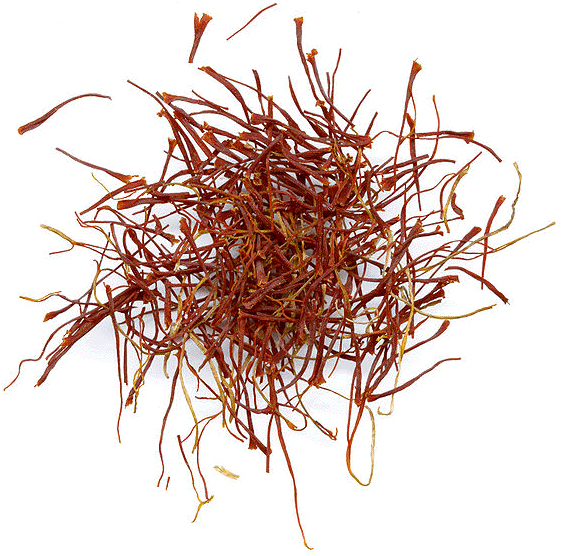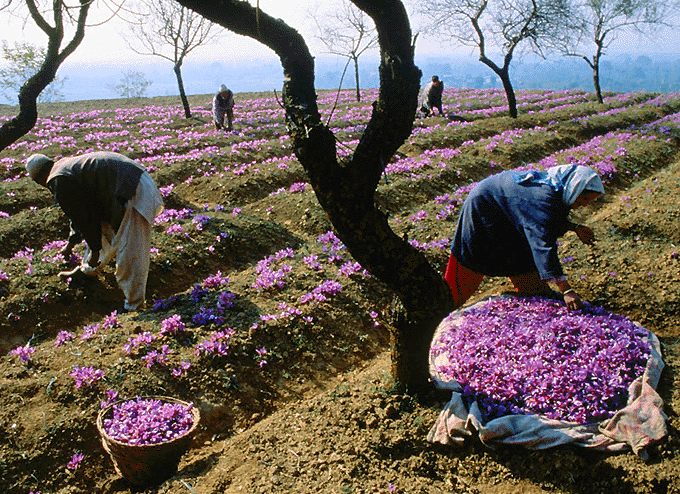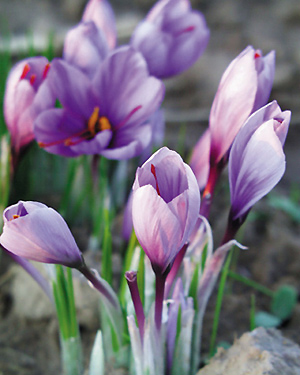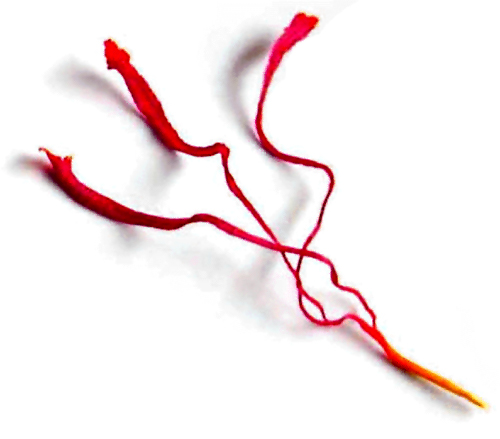
|
|
|
|
BY: SUN STAFF
 Aug 24, 2010 — CANADA (SUN) — A journey through India: border to border, bhoga to prasadam. One of the most fascinating spices used in Indian cooking is Saffron. Known as the royal spice, or 'spice of the Kings', saffron is one the most expensive cooking ingredients in the world, and certainly the most expensive spice. This super-excellent stuff comes from the stigma (female organ) of the Crocus (Sativus linneaus), which today is grown the world over. Each jewel-like little crocus flower has just three stigmas, and it takes more than 75,000 flowers to produce a single pound of saffron, which is the brittle filaments made by drying the red stigma. One acre will yield only ten pounds of saffron, and the delicate stigma must be harvested very carefully, by hand.
Saffron is an ancient cooking ingredient, and there is a fair bit of disagreement about where the Crocus was first colonized and how its cultivation spread around the globe. One of the Sanskrit terms for saffron is kashmirajanman or 'product of Kashmir', and Kashmir continues to be one of the most important growing regions in India.

Saffron Harvest in Kashmir We find many references to kinjalka in Srmad Bhagavatam, where the term is translated as 'saffron'. For example, there are descriptions of garments that are "yellowish like the saffron of a kadamba flower", or "yellowish like the filaments of a lotus". Sri Krsna's garments are described as being "like flying saffron pollen from lotus flowers". Likewise, in Brahma-samhita we read, "There exists a divine lotus of a thousand petals, augmented by millions of filaments, in the transcendental land of Goloka." There are even more references in sastra to kumkuma (kunkuma) powder, which is worn by Srimati Radharani, the gopis and other divine Mothers as a cosmetic. There are several ancient recipes for making kumkuma, perhaps the most common of which is ground dried turmeric to which a few drops of lime is added, changing it to a bright red color. Kumkuma is also called 'vermillion', and that term refers to the color rather than the source of the pigment. Likewise, kumkuma is sometimes described as 'saffron', and in Srimad Bhagavatam 10.5.10 we find the term, nava-kunkuma-kinjalka -- " with saffron and newly grown kunkuma flower". Altogether, many of these references suggest that the 'saffron' being referred to is different than the saffron we cook with, which is the dried stigma of the Crocus flower. In India, cooking saffron is famously produced in Kashmir, as we will describe in more detail later on. This leads us to an interesting verse in Sri Caitanya-caritamrta, Adi lila 13, where kunkuma is not only mentioned distinctly from turmeric (haridra), it is also described as a scent produced in Kashmir. This suggests that kunkuma may sometimes be synonymous with saffron from the Crocus. Adi 13.114
SYNONYMS TRANSLATION So it appears that the terms kinjalka and kunkuma, both of which translate to 'saffron', very likely describe the powdered pigments that come from various varieties of flower stigma. Whether the blooms be Crocus, Lotus or 'kunkuma, there are many flowers that produce a heavy powder on their stigma. There are various Sanskrit terms used for 'saffron', including kunkuma (kumkuma), kashmiirajan, kashmiiran, and nagakeshara. Nagakeshara is the name of a tree common throughout South India, known as Nageshwar, whose blooms have many stigmas with abundant yellowish-red powder. But among all these flowers, only Crocus stigma are harvested and dried for use as cooking saffron.

Being a desirable spice across India, there are words for cooking saffron in many regional dialects. It's known as kesar (keshar, kesara) in Hindi, Gujarati, Nepali, Marathi, Kannada, Urdu and Oriya. In Bengali it's known as japhran, in Hindi, Kashmiri and Urdu it's zafran. It's called kunkuma in Kannada, Nepali and Sanskrit, and in South Indian dialects it's known as kungumampoovu (Malayalam), kungumappu (Tamil), and Kunkumapuvvu (Telugu). Elsewhere it's called agnishikhe (Kannada), and Chitekedu. Among the qualities that have made saffron so highly valued as a cooking ingredient are its intense and distinctive flavor, pungent aroma, and coloring potency. All three leave an impressive mark on every dish it's used in. Added to liquids like bullion or broth, or to milk products, saffron quickly turns the base into a beautiful bright orangish-yellow color, and the color remains throughout the cooking process. The potency of saffron's flavor, while immediately a strong presence in foods, actually increases with time. For the full impact, saffron mixed into sauces, creams or sweets should be allowed to sit overnight, as the flavor will be even more pronounced and excellent the next day. This also means, of course, that a judicious quantity should be used in preps, particularly if they're not offered immediately. In our recent series on Ghee we shared a recipe that really showcases this particular quality of saffron – the Stuffed Baby Potatoes in Saffron Cream. Allowed to steep for 12 hours or so in the refrigerator, the saffron cream sauce becomes a beautiful bold yellow, and the saffron flavor permeates the potatoes. Over the next few segments we'll talk about saffron's excellent use in sweets, breads, sabjis and rice dishes, among others, but first let's consider it's most basic use: in beverages. The color, aroma and flavor are all released from saffron when the strands are steeped in liquid. Whether your liquid base is milk, an acidic fruit juice, or simply a cup of tea, let the saffron steep, covered, for at least 20 minutes, and preferably in a hot liquid. By doing so, saffron's three primary constituents are released -- saffranal, crocin and crocetin -- which provide saffron's wonderful exotic fragrance and flavor. Saffron has a natural affinity for dairy products, and is beautifully used in anything containing milk, cream, buttermilk, yoghurt, etc. Saffron steeped in hot milk is a classic Vedic preparation to be taken at bedtime. Srila Prabhupada appreciated it, and it is often served to the Deities in Krsna temples. Saffron alone in milk has a slightly bitter or metallic taste that is very pleasing, but it's also nice sweetened with jaggery or honey.


One of the sweet drinks commonly enjoyed in ancient India was water sweetened with raw sugar, to which aromatic spices like saffron, camphor or sandalwood were added. Fresh fruit juices were also used. Saffron tea, made by simply steeping the saffron in hot water, can also be cooled down and served as an iced drink or sharbat. Released by the heat, the full flavor will infuse the water and it will remain flavorful after it's chilled. You can add any other herbal tea you like to the mix, to suite your taste. In the cold months, saffron tea is said to be an excellent remedy for the lungs. Thandai is another traditional cooling drink that can be prepared with saffron infused water or fruit juice. A blend of almonds, fennel seeds, rose water, saffron, and black peppercorns can be ground together, mixed with chilled saffron water or milk, and sweetened. For a simple sharbat, add saffron to the pot while making sugar syrup, let it cool, and serve it on ice. 
There are several basic methods to use when cooking with saffron, and all can be applied to making saffron beverages. The first is steeping the saffron strands in hot liquid, as described above. The second method is steeping whole saffron strands in liquid that's room temperature or cooled, letting them steep for a much longer time -- at least a few hours and preferably overnight. Don't crush the threads, but let them remain whole, and stir them around a few times so they become fully absorbent. They'll soak up the liquid, leaving plumped strands that are beautiful in beverages or mixed into puddings or sweets. Use at least three times more liquid than the volume of saffron. A quicker method for using saffron is to steep it in a scant amount of liquid for 10 to 20 minutes, mashing the threads with the back of a spoon until they become a thick paste. The paste can then be added to dishes for instant and potent saffron spicing, and leftover paste can be stored in a sealed container and kept for days. You can also toast the saffron, lightly frying it in a dry pan over low heat until it darkens a few shades, then grind the threads to a powder with the back of a spoon. Following are several more excellent beverages featuring saffron. In the Green Mango drink, the saffron adds to the 'zing' of the raw mango, just as it does with the limes in the Orissan drink, Panakam. Ingredients: Mixed all the ingredients thoroughly. Serve the sharbat chilled with crushed ice. Decorate with fresh rose petals. Ingredients: Bake one large or 2 medium green mangos at 300 degrees for 30-40 minutes, until the flesh is soft. Cool, deseed and scrape out the flesh. Puree in blender, adding water, sugar, saffron, cardamom and fennel. Strain through a sieve. Add crushed ice and offer. Ingredients: Squeeze the limes and mix all the ingredients. Add ice, if desired, and offer. Ingredients: Soak saffron in the hot milk and rub till dissolved. Mix sugar in with the curds till well dissolved. Just before serving, combine all the ingredients. Whip well with a hand or electric beater. The lassi is ready when it is light and frothy. Offer well chilled.

| |